
What is Market Research and How Do You Do It Effectively?
Have you ever wondered how some of the most successful businesses know exactly what products to sell and when to sell them? The answer is by utilising effective market research.
Market research is when business owners collect data about the market they are working in, like information about their customers, competitors and even target market. Without market research, you are essentially working blind and can only make business decisions based on past trends or in a vacuum, and you won’t be able to market your brand effectively or choose the right products to sell, causing you to fall way behind your competitors and come up empty when it comes to any type of profit. Market research helps you keep your target audience as the focal point of every decision you make as a business.
What is market research?
The dictionary defines market research as the action or activity of gathering information about consumers’ needs and preferences. Consumers include your customers, but market research is also relevant to the competitors you are selling against and the industry you are selling in. It is an effective way to test either a product or service your business is thinking of offering and is crucial if you want your business to be successful. It helps you stay on top of trends in the market, grow and scale your business and set up marketing plans.

To effectively carry out market research, you need to get to know your consumer’s buying habits, like how your customers shop and what they want. Studies show that businesses that focus the majority of their time on customers are 60 per cent more profitable. Conducting market research helps you do this, and allows you to see if a product will do well. It influences a lot of your business decisions, and if customers don’t respond well to certain things it then gives you a chance to change things accordingly.
What are the different types of market research?
The market research process has two main types of research: primary research and secondary research. Primary market research is the data and information gathered by the company about their specific customers and industry, and secondary research is data that has already been collected by a government entity or competitor and is usually more general in nature.
Primary market research
Primary research data collection can either be collected by the retailer themselves, or by third party researchers who collect the information on behalf of the retailer. This type of market research is more specific in nature and includes first hand information about your target market, ideal audience and competitors. It can be either exploratory, which includes open-ended questions that aim to draw broad results, or specific, which aims to get more definitive answers that are full of detail.
Different types of primary market research
Interviews
Interviews can be one of the best ways to test how well your target customers might respond to products. You can have genuine conversations with your customers and get insights into what they want from analysing their body language. The best part is you can conduct these interviews virtually if it is too difficult to do them face-to-face, and you can still get the same level of insights.
Interviews essentially set up the foundation of your own market research. You should ask questions about your customers’ jobs, ages, and various questions about their lifestyles and how they shop, allowing you to collect customer data and create profiles that will help you along the way during your market research. You can determine how you want to market your products and what kinds of products you want to sell based on interviews because you can find out exactly what your customers want.
Focus groups
Focus groups involve gathering together a sample of people to test either a product or a service. These are usually done after a retailer has determined their target audience and has decided on a new product or advertisement.
Essentially, you show the focus group your product or service and ask them to provide you with feedback. You can choose to ask the questions either individually or in a group, keeping in mind that some people may be influenced by other people’s opinions if they are grouped together for questioning.

Film companies often use a focus group to test their movies before release dates. They will get a group of people in a theatre and play them a screening of the film, watching how people react and taking note of how many laughs they get or if people were surprised or disappointed by the ending. They will then provide questionnaires to gauge how likeable the movie was and will change things according to the feedback.
Focus groups are a great way to ensure the success of a product or service because they give you a good idea of whether or not people will like what you are selling before the actual release date, helping to remove a lot of risks associated with investing in new products.
Although it may take time, the best option for this market research strategy is to show people the product or service in a group setting, split them up for feedback or ask them to fill out a questionnaire at the end of the session. This is a great way to get real-time feedback and opinions that are unbiased compared to if you were to ask company employees for feedback on new products.
A focus group provides qualitative data or data that gives more specific answers from a smaller amount of people.
Surveys
This is one of the easiest ways to gather information about your customers and their thoughts on your products and services on a large scale. Surveys are extremely cost effective and simple, but won’t be as specific as interviews, focus groups or product testing.
Surveys can also be difficult to have people complete, as many customers tend to ignore them. This is when it is important to provide an incentive for your customers, like going into the draw to win a gift card for their next purchase or providing a small discount.
One of the best ways to incorporate surveys is by sending them out in automated emails a few weeks after a customer has purchased an item. This way, the customer has had enough time to test out the product and provide accurate and relevant feedback.
Online surveys let you get to know how your customers use your products and why, as well as their motivations for purchasing. Each answer helps you piece together the puzzle that will eventually make up your market research, and you will be able to make business decisions much faster with this information.
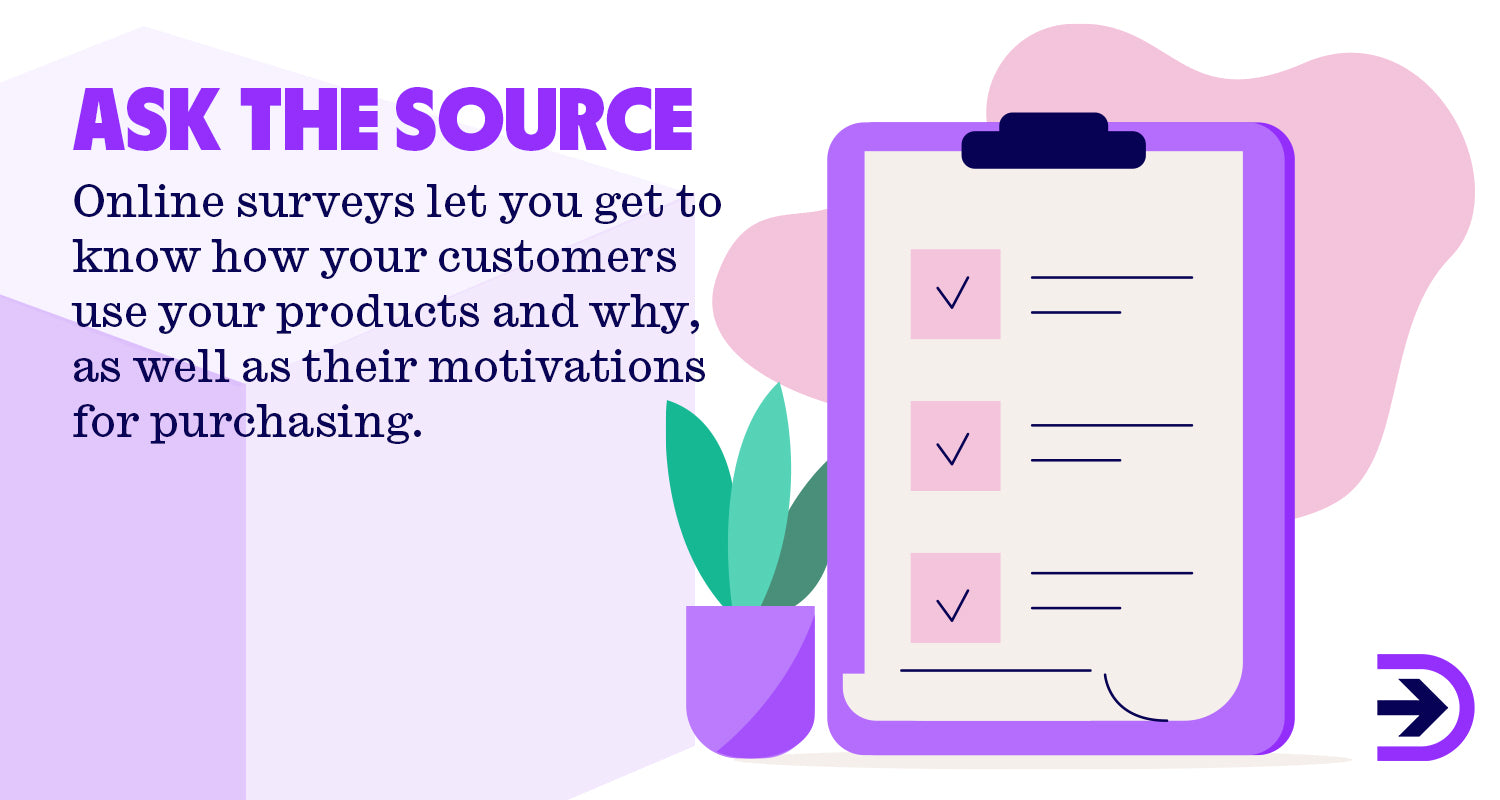
Your surveys should be long enough to provide enough data for your market research, but not too long that customers don’t want to finish them. We suggest no longer than five minutes in length of mostly multiple choice or scale-type questions so customers can complete them as quickly as possible. Most of the time, if you are providing great customer service and products, your consumers will be more than happy to answer a few questions to help you out.
Surveys can help you collect large amounts of quantitative research, which is data that helps companies draw conclusions from lots of answers.
Observations
This is one of the simplest modes of primary research, as it only involves the ongoing observation of different events and their outcomes. For example, if a marketing campaign is rolled out, take notice of how many sales you make because of this; did people respond well? Do you notice you have an increased spike in sales when you post a how-to video on your Instagram stories?
Pros and cons of primary research
Pros
Unlike secondary research, this type of research is conducted by the retailer, so it is directly related to their customer base, meaning the market research is more accurate and therefore more effective. The research has also never been used before, and is much more specific so can be more helpful when it comes to creating products or deciding on marketing strategies.
Cons
It can be more difficult to organise the collection of this type of research. It requires more investments of your money and time depending on whether or not you hire an outside company to conduct the research.
Qualitative vs quantitative research
Qualitative
Qualitative research focuses more on specific insights about your consumers, like what they think of a product or what they want to get out of it.
Quantitative
This type of research focuses on market research data that is broader in nature, like data and statistics about how many customers are visiting a product page, your social media engagement and trends in the industry.
Secondary market research
This is data that has already been collected by another business and will tell you more general information about market trends and industry data based on what has already happened. This can include things like yearly trend reports conducted by the government or trend reports conducted by your competitors that are relevant to your chosen market and help you with analysing competitors. Data Reportal is a great place for yearly data and insights about Australians in the digital space, and is a great secondary market research tool to use alongside your surveys, focus groups and other findings.

Pros and cons of secondary research
Pros
If you’re a small business or just starting out, secondary research is extremely cost-effective and easy to find, so it’s great for companies looking for a cheaper option that takes less time to find.
Cons
This type of research isn’t specific to your business, and you might struggle to find the exact data you need. This could mean that you don’t market your products in exactly the right way, or maybe the data you have found is outdated and irrelevant to the current market.
What do you need before you conduct market research?
There are a few things you need to collect before you begin conducting marketing research that ensures you ask the right questions and keep your business goals at the forefront.
Audience profiles: Find your target market
The research process should begin with finding out who your target market is, from there you can begin building audience profiles. This process is called buyer segmentation, when you separate your target audience from the general public and create a profile about them, including age, job, interests or hobbies, annual income, and gender.
Think of creating an audience profile as creating a character, and this character will be who you aim to cater your products to. They will be your priority, the person you want to make sure you are satisfying.
Buyer segmentation will influence all your future decisions, which will in turn make it easier for you to be more specific with your product goals and what you want to achieve with marketing strategies.
Prepared research questions
Before you conduct any type of primary market research, you first have to know what questions you are going to ask. There’s no use in asking the first thing to pop into your head, if you want to get the most out of your market research you have to put thought into the kinds of questions you are going to ask.
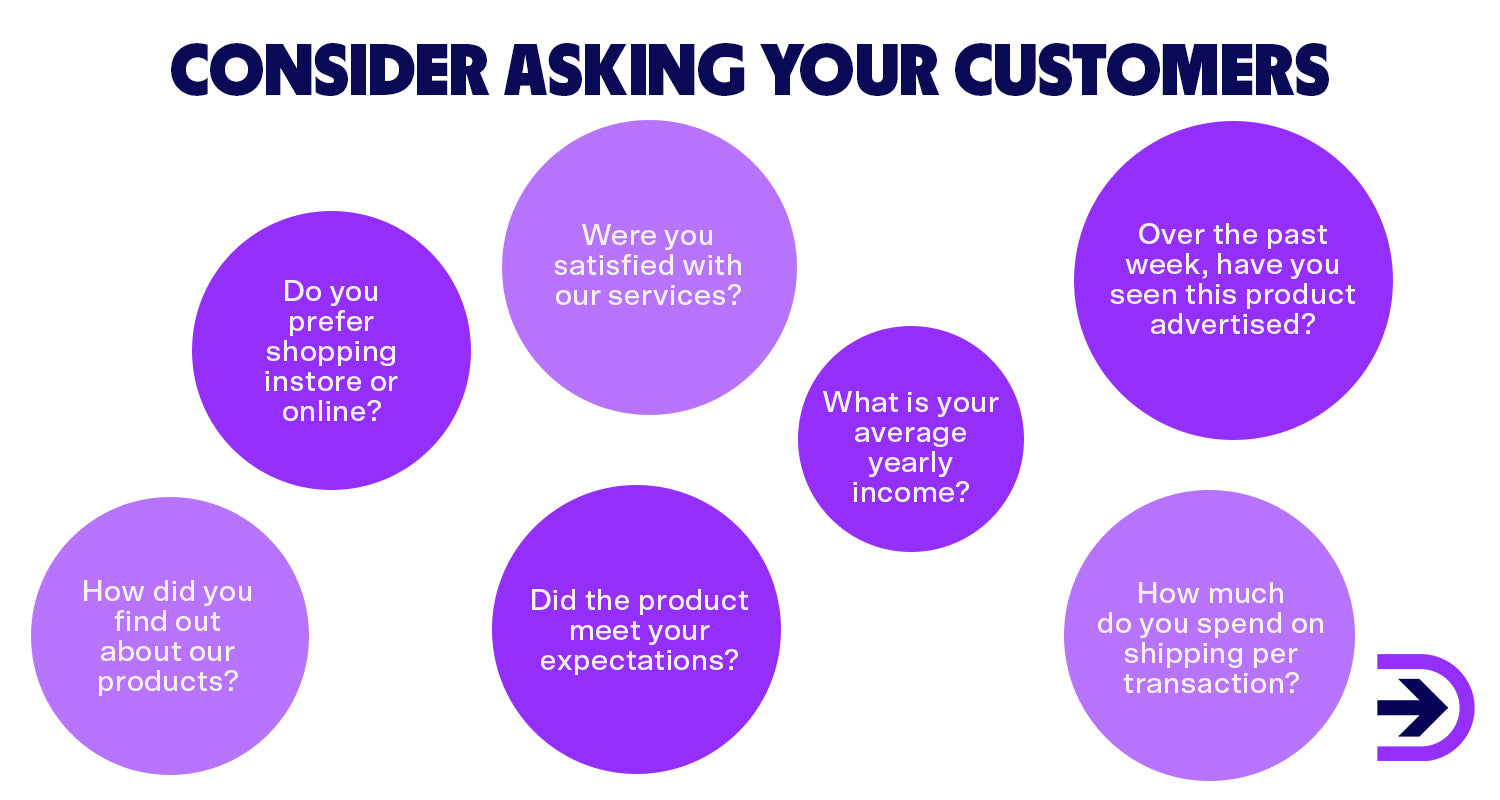
First, consider what you want to discover from your survey or interview. You can ask demographic-based questions like:
-
What is your age, career, and relationship status?
-
What is your average yearly income?
-
What is your level of education?
-
Do you prefer shopping instore or online?
-
How much do you spend on shipping per transaction?
You can ask questions about what your customer thinks of your products:
-
Were you satisfied with our services?
-
Did the product meet your expectations?
-
Do you think the pricing of this product is adequate?
-
How did you find out about our products?
Or, you can ask questions about marketing campaigns:
-
What did you think of this advertisement?
-
Over the past week, have you seen this product advertised?
The main thing to remember is that you don’t want to bombard your customers with questions, as they are likely to feel overwhelmed if a survey if it is too long. Think about what you need to be answered and go from there, once you have an outline of your research questions you can rest assured that you will gain valuable insights from your market research.
Competitor profiles
It is important to identify who your competitors are to compete against them and stay one step ahead. Competitor profiles give you insights into what kinds of marketing strategies they use, how popular they are and what kinds of products they are selling. From there, you can easily analyse what is and isn’t working, and figure out how to fill some of the missing gaps to help you appeal to more customers.
You should also take note of what kinds of perks your competitors offer, like low shipping prices, discounts and subscription options. What kinds of fulfilment strategies do they use, what technology have they implemented, and does it work well?
You can find out who your competitors are by determining where your target audience is shopping. Compare the key features of your products versus your competitors. From there, you can determine what their pricing is like and how they market their products to help you strengthen your decision-making process. Do your competitors publish weekly blogs and other content? Do they post regularly and have a good social media presence? For almost every decision you make about your company, you should take note of what your competitors are doing.
How do you effectively do primary market research?
Having a good idea of who your target audience is and what kinds of questions you want to ask them will be the first step to ensuring your primary market research is as effective as possible. You also want to make sure you interview enough people to get enough information. Only interviewing five people won’t give you enough conclusive evidence and will be detrimental to your decision-making. Ensuring you don’t ask leading questions to sway your customers’ answers is also important, as you want your data and insights to be as accurate and unbiased as possible so they can be applied to a wider audience.
The last step is to not ignore any negative feedback you get, as this can more often than not provide you with the most important insights to help you improve customer satisfaction. For example, if you find that a large majority of people aren’t happy with the fact that your candle company only offers single-wick candles, you will want to consider introducing different options to ensure customers don’t find a competitor who offers three-wick candles.
How does secondary market research complement your primary research?
Secondary research can be used alongside primary research to support data and trends discovered through primary research. Once you have asked the right questions and have your answers, you can use the findings of other people and companies to enhance your insights and ensure their accuracy.
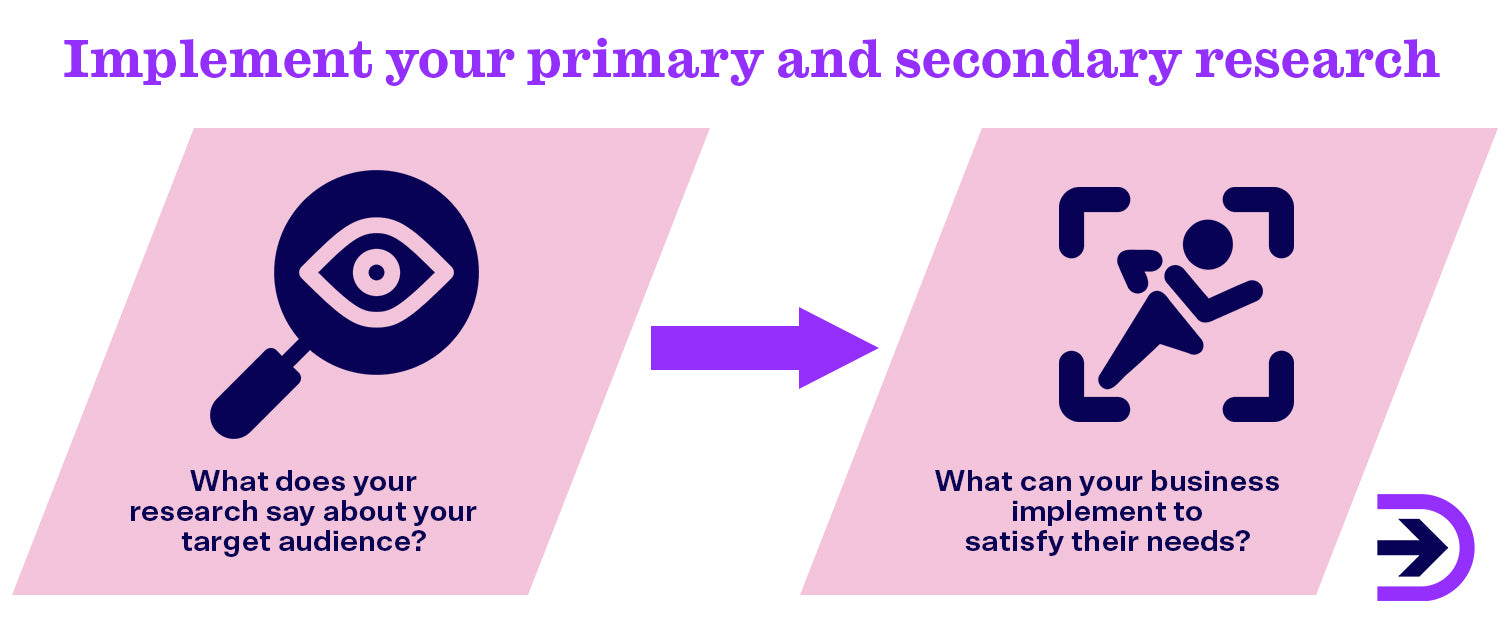
Secondary research is extremely beneficial to the market research you conduct. For one, it can provide a much larger range of data that is more likely to give you broad insights that represent more perspectives. For example, you could only get 50-100 customers to complete your survey at best. Secondary research findings will give you access to Australia-wide statistics, and even global statistics that can give you a great idea of industry trends. Secondary research can also help you work out what kind of questions you need to ask as it gives you a good background into what you should be aiming to find out.
Turning your findings into actionable insights
Once you have gathered your market research findings, and have ensured they are high-quality and can add something to your business decisions, you can start to implement them into actionable insights.
You should ensure that everyone who is involved in your business decisions has access to your market research insights and that the data is presented in an engaging and visually-creative way so that they are easy to understand. This way, each employee is aware of what they are aiming to achieve and why, ensuring things like the development of marketing strategies become more seamless.
The most important thing to think about when looking at the data you have collected is what it tells you about your target audience, as this will help turn your data into insights that can be applied to marketing strategies. This is where it is helpful to focus on your qualitative data like specific answers and feedback customers have given, as it gives you the chance to step into the shoes of your customers and better understand them. It is much easier to gain insights from these rather than from large amounts of quantitative data. For example, if you are seeing lots of social media comments about how customers are unhappy with how contactable your business is, you should think about implementing something like a live chat feature on your website. Or if you notice customers loving a particular product but want to see it in more colours, you can weigh up whether creating more colourways will be beneficial to your business and your profitability.
Does market research help your online dropshipping business?
Market research is extremely beneficial to the success of your dropshipping business. With the rise of the digital age, it is becoming even easier to collect data about your customers, competitors, and the industry. Market research is the number one tool that can help you with your business planning, covering everything from predicting seasonality changes to deciding on your products and marketing strategies.
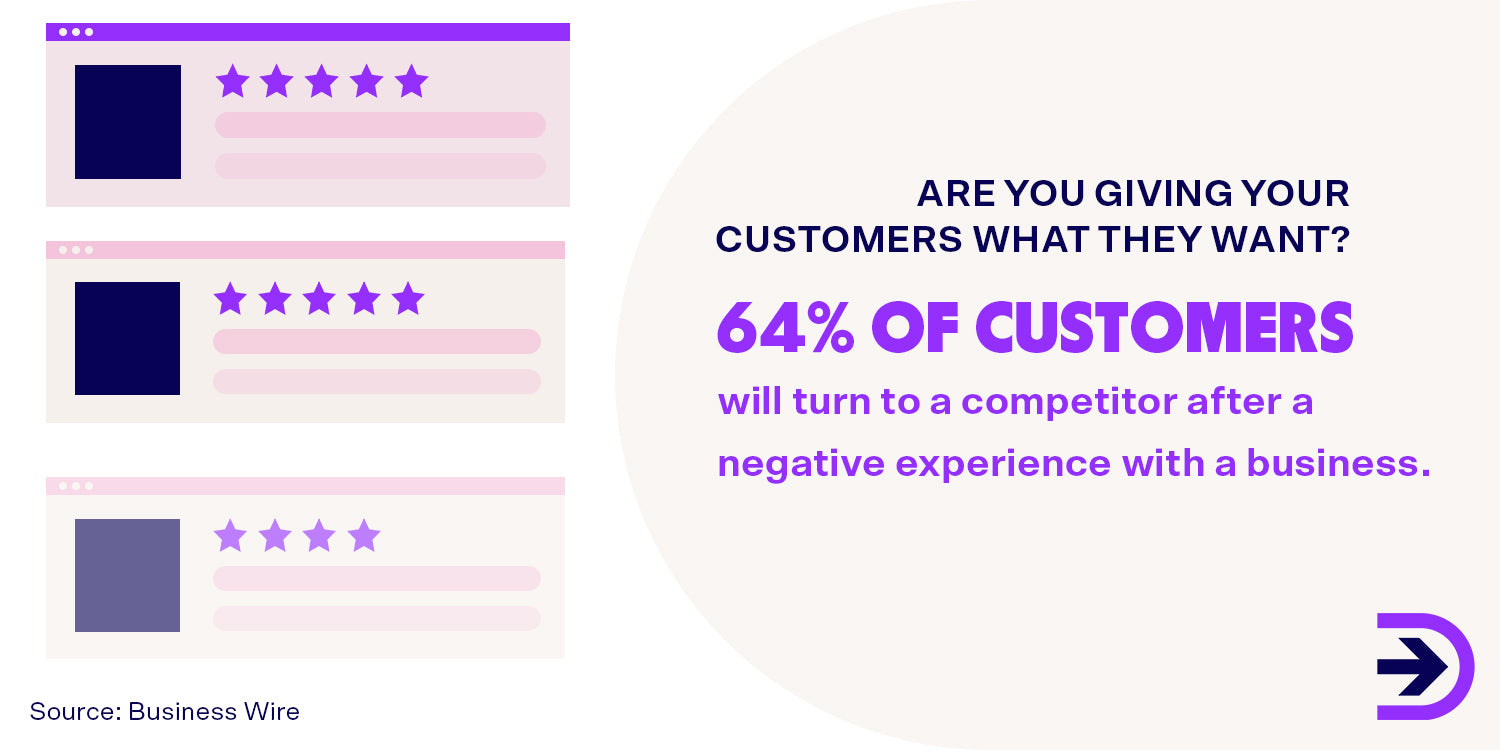
Effective market research gives you the ability to understand what will and won’t work when it comes to the products they are selling and their marketing strategies. You are therefore much more likely to succeed in your endeavours because you have the chance to see how people might react to certain products and services and can adjust accordingly to help reduce the risk of losing sales. Market research also helps to identify any threats that might happen down the line.
Market research not only helps you find potential customers but can also reduce your number of bad customer experiences because you can tailor your products and marketing strategies specifically for your target audience. Because 64 per cent of customers will turn to a competitor after a negative experience with a business, market research will help you avoid this.
Get started with Dropshipzone today and build your successful ecommerce business today.
Recommended tools for market research
Conducting market research doesn’t have to be super complicated and time consuming, with new technological advancements you can easily gather large amounts of data without relying too much on the more traditional research strategies of the past.
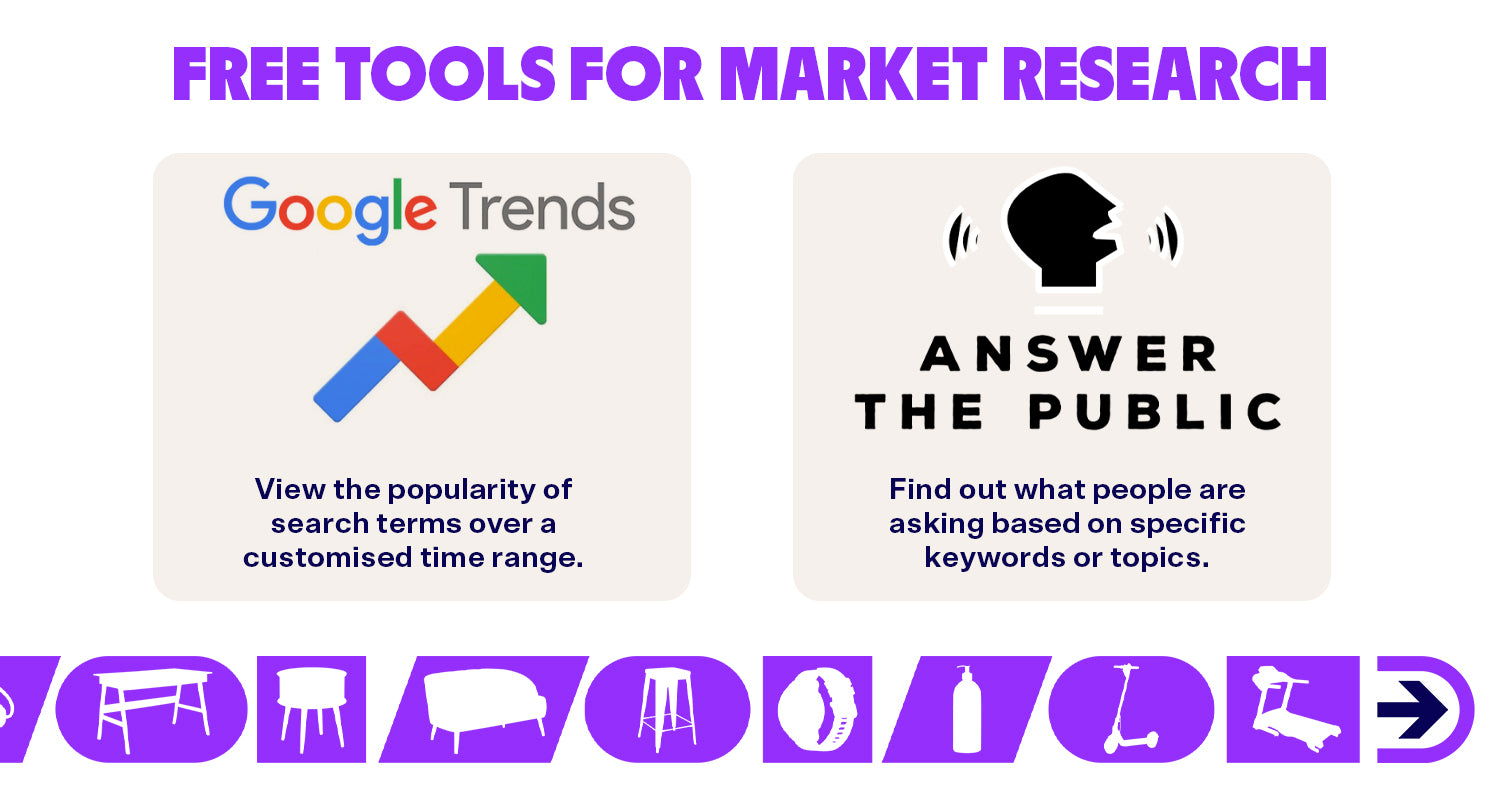
Free tools for market research
Google Trends
Google Trends is a free tool where you can search for specific terms and see how popular those terms have been over a certain amount of time. You can set the location you want to focus on and see trends from anywhere in the world within a customisable time range. Google is where everyone goes to find information, so this tool can give you an instant snapshot of a large amount of the population.
Answer the Public
This is another free market research tool that tells you what kinds of questions people are asking based on a few keywords or topics. For example, if you search the term ‘market research’, you will see that some of the most popular questions people are asking include things like ‘why is market research important?’ and ‘how is market research done?’.
Answer the Public also tells you things like the search volume of a particular keyword or topic, giving you a good idea of how many people are interested in a product or service.
Think with Google
This tool is essentially a library full of resources that will be valuable to your business, with everything from global consumer insights to advice on marketing strategies. Think with Google is an exceptional free tool that can help you stay on top of trends in the market.
Paid tools for market research
The following tools all have paid subscription plans, so if you are wanting more specific data and insights, these are the tools we suggest using.
Survey Monkey
If you’ve ever done an online survey, chances are that you’ve heard of Survey Monkey. It’s one of the most popular tools used to create surveys that can then be sent out to customers through emails or social media posts. Survey Monkey gives you the ability to survey multiple customers, from there you can choose to see individual answers and compile each answer to draw trends in the data.
Statista
Statista is one of the largest sources of statistics online and offers data reports in graph forms on a large variety of topics. Any trend you want to learn more about can most likely be found on Statista, and the website is constantly updated with new data to help you stay on top of changing trends.
Uber Suggest
Uber Suggest is another market research tool that allows you to search a keyword or phrase and see related keywords that customers are searching for. If you enter your or a competitor’s domain name, it can give you valuable advice on how to improve that website, so it is extremely helpful when setting up the foundations of your market research.
FAQs
What are the main types of market research?
The two main types of market research are primary and secondary research.
What is the difference between primary and secondary research?
Primary market research is conducted by you or someone you have employed, whereas secondary market research has already been conducted by government agencies or other competitors.
How does market research help your business?
Market research allows you to predict how customers will react to your products and marketing campaigns, so it reduces your risk of failing or losing money.
What are some examples of market research?
Some examples of market research include conducting customer interviews, surveys, focus groups or product testing.








